An audit team leader arrives at a printing company to carry out a Stage 2 audit for a certification body. At a meeting with the Quality Manager, she is told that they have won their biggest contract from a computer manufacturer to print and compile computer documentation packages. The Quality Manager wants the ISO 9001 certificate to cover the new contract.
During the audit, a team member found that some print jobs had been rejected by several clients over some months due to spelling errors in the print run. The Print Manager blames the new employees they had to take on because of a big contract.
The auditor finds that the responsibility for checking spelling errors is placed on the printer that sets up the print run.
In line with the policy of the certification body, the audit team raise improvement opportunities in the audit report. Which
three of the following options would represent acceptable opportunities for improvement in the report?
You are conducting an audit at a single-site organisation seeking certification to ISO 9001 for the first time. The organisation manufactures cosmetics for major retailers and the name of the retailer supplied appears on the product packaging. Sales turnover has increased significantly over the past five years
You are interviewing the new Product Development Manager. You note that a software application called SWIFT is used to help control the product development process.
You have gathered audit evidence as outlined in the table. Match the ISO 9001 clause 8.3 extracts to the audit evidence.
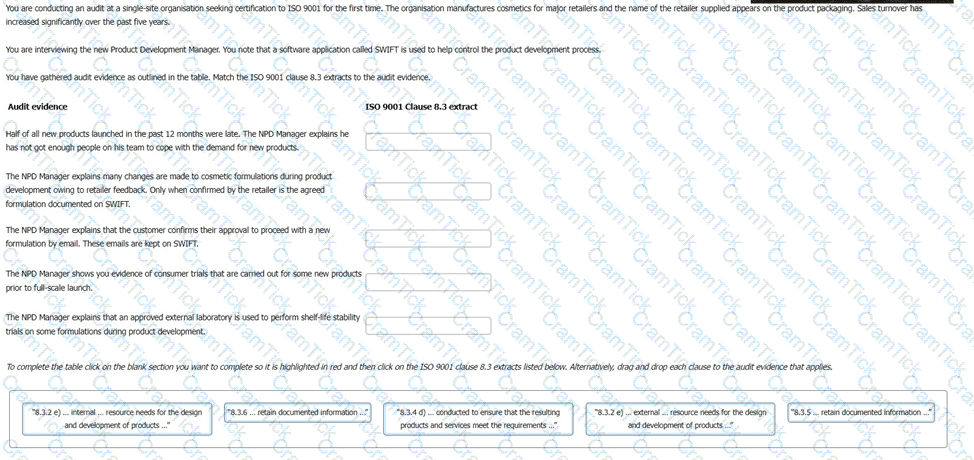
Scenario 1: AL-TAX is a company located in California which provides financial and accounting services. The company manages the finances of 17 companies and now is seeking to expand their business even more The CEO of AL-TAX, Liam Durham, claims that the company seeks to provide top-notch services to their clients Recently, there were a number of new companies interested in the services provided by AL-TAX.
In order to fulfill the requirements of new clients and further improve quality, Liam discussed with other top management members the idea of implementing a quality management system (QMS) based on ISO 9001. During the discussion, one of the members of the top management claimed that the size of the company was not large enough to implement a QMS. In addition, another member claimed that a QMS is not applicable for the industry in which AL TAX operates. However, as the majority of the members voted for implementing the QMS. Liam initiated the project.
Initially, Liam hired an experienced consultant to help AL-TAX with the implementation of the QMS. They started by planning and developing processes and methods for the establishment of a QMS based on ISO 9001. Furthermore, they ensured that the quality policy is appropriate to the purpose and context of AL TAX and communicated to all employees. In addition, they also tried to follow a process that enables the company to ensure that its processes are adequately resourced and managed, and that improvement opportunities are determined.
During the implementation process, Liam and the consultant focused on determining the factors that could hinder their processes from achieving the planned results and implemented some preventive actions in order to avoid potential nonconformities Six months after the implementation of the QMS. AL-TAX conducted an internal audit. The results of the internal audit revealed that the QMS was not fulfilling all requirements of ISO 9001. A serious issue was that the QMS was not fulfilling the requirements of clause 5.1.2 Customer focus and had also not ensured clear and open communication channels with suppliers.
Throughout the next three years, the company worked on improving its QMS through the PDCA cycle in the respective areas. To assess the effectiveness of the intended actions while causing minimal disruptions, they tested changes that need to be made on a smaller scale. After taking necessary actions, AL-TAX decided to apply for certification against ISO 9001.
Based on the scenario above, answer the following question:
According to scenario 1, AL-TAX determined the factors that could hinder their processes from achieving the planned results and implemented preventive actions. This means they employed:
XYZ Corporation is an organisation that employs 100 people. As the audit team leader, you conduct a certification audit at Stage 1. When reviewing the quality management system (QMS), you find that the objectives have been defined by an external consultant using those of a competitor, but nothing is documented. The Quality Manager complains that this has created a lot of resistance to the QMS, and the Chief Executive is asking questions about how much it will cost.
Which two options describe the circumstances in which you could raise a nonconformity against clause 6.2 of ISO 9001?
Match each of the following statements into the table below to show whether they apply to first-party audits, second-party audits or third-party audits:

Whistlekleen is a national dry cleaning and laundry company with 50 shops. You are conducting a surveillance audit of the Head Office and are sampling customer
complaints. You find that 80% of complaints originate from five shops in the same region. Most of these complaints relate to damage to customer laundry. The Quality
Manager tells you that these are the oldest shops in the company. The cleaning equipment needs replacing but the company cannot afford it at the moment. You learn
that the shop managers were told to dismiss most of the claims on the basis of the poor quality of the laundered materials.
On raising the matter with senior management, you are told that there are plans to replace the equipment in these shops over the next five years.
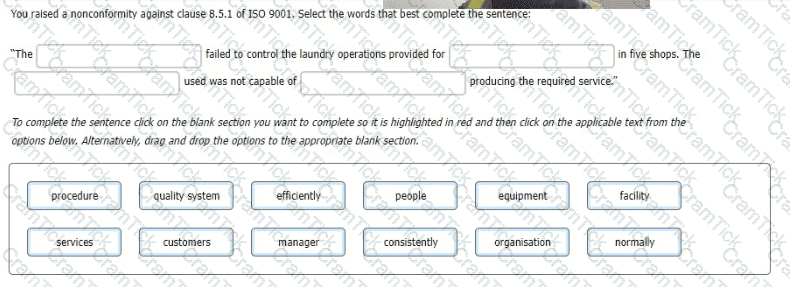
In the context of a third-party management system certification audit, which two of the following statements are correct?
You are carrying out an audit at an organisation seeking certification to ISO 9001 for the first time. The organisation offers regulatory consultancy services to manufacturers of cosmetics. The business operates from ten regional offices.
You are nearing the end of the audit and need to decide if sufficient evidence of top management leadership and commitment with respect to the quality management system has been gathered.
Which four of the following would demonstrate top management leadership and commitment with respect to the quality management system?
You are preparing for interviews with two members of top management. Based on the information that you gathered about the organization, you conclude that it is the top management who takes all the important decisions and closely supervises and controls employees. Based on this, which management style is practiced in the organization?
You are carrying out an audit at a single-site organisation seeking certification to ISO 9001 for the first time. The
organisation manufactures cosmetics for major retailers and the name of the retailer supplied appears on the product
packaging. Sales turnover has increased significantly over the past five years. The organisation uses a software programme called SWIFT, which is used to record sales, plan production, purchase supplies, print despatch notes, track new product development, perform traceability exercises, carry out mass balance checks, raise invoices, create budgets, and support financial control.
You are nearing the end of the audit and you are reviewing your audit notes. You notice a recurring trend concerning the SWIFT database as shown below:
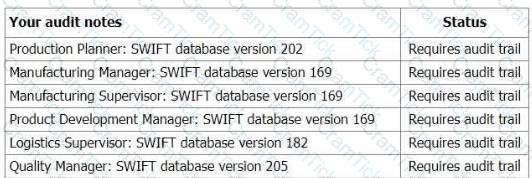
You ask the Quality Manager to explain how the SWIFT database is controlled. You learn that the Operations Director is
responsible for determining and progressing SWIFT software updates. You decide to meet the Operations Director (OD).
You: "Good afternoon."
OD: "Good afternoon."
You: "What responsibility do you have concerning the SWIFT database?"
OD: "I maintain it. If anyone wishes to propose an update to the database, they send me an email with
details of their proposal. I then either process the database update myself, or I send the request to the
consultant who designed the database 20 years ago. The necessary software changes are made, and the
amended software is immediately released to users."
You: "Would you explain how the software amendments are controlled?"
OD: "Of course. I personally update every computer myself."
You: "Do you inform the database users of the changes?"
OD: "No I don't. They find out for themselves by using the software, or they come to see me if they have
any questions."
You: "How do you ensure that the database users use the latest version?"
OD: "That's easy, I update every computer myself."
You: "During the audit, I noted there were several versions of SWIFT in use (you refer to your audit
notes)."
OD: "I know. That's because some versions work better than others, and depending on user needs and
experiences, we allow users to revert to using an earlier version if they find it works better for them."
Based on the scenario, which two of the following statements are true? There is evidence of
nonconformity with a requirement defined in ...
A small deaning services organisation is about to start work on a hospital dleaning contract for the local Health Trust. You, as auditor, are conducting a Stage 2 audit to ISO 9001 and review the contract with the Service Manager. The contract requires that a cleaning plan is produced. You: "How was the cleaning plan for the contract developed?" Service Manager: "We have a basic template that covers the materials, labour requirements and cleaning methods to be employed. Some of that is specified by the customer." You: "How does the plan deal with locations like the intensive care wards and the operating theatres, which are included in the contract?" Service Manager: "The basic plan covers general wards, but we will do more frequent cleaning in those areas if the hospital requests it." You: "Are you aware of the regulatory requirements for cleaning standards in hospitals?" Service Manager: "No. We depend on the hospital to look after that side of things in the contract." You decide to raise a non-conformity against section 8.2.2.a.1 of ISO 9001. You decide to raise another non-conformity against section 8.2.4 of ISO 9001 when finding that the cleaning plan was amended without the agreement of the Health Trust. A different cleaning chemical was substituted to that specified in the contract. At the follow- up audit, the corrective action proposed was to "obtain a concession from the Health Trust for use of the new chemical." Which one of the following options is the reason why you did not accept this action taken?
XYZ Corporation employs 100 people, and during a Stage 1 certification audit, certain issues are identified with the Quality Management System (QMS). Which two options describe the circumstances in which you could raise a nonconformity against Clause 6.2 of ISO 9001:2015?
Scenario 2:
Bell is a Canadian food manufacturing company that operates globally. Their main products include nuts, dried fruits, and confections. Bell has always prioritized product quality and has maintained a good reputation for many years. However, the company's production error rate increased significantly, leading to more customer complaints.
To increase efficiency and customer satisfaction, Bell implemented a Quality Management System (QMS) based on ISO 9001. The top management established a QMS implementation team comprising five middle managers from various departments, including Leslie, the quality manager.
Leslie was responsible for assigning responsibilities and authorities for QMS-related roles. He also suggested including a top management representative in the QMS team, but top management declined due to other priorities.
The team defined the QMS scope as:
"The scope of the QMS includes all activities related to food processing."
Leslie established a quality policy and presented it to the team for review before top management approval. Top management also proposed a new strategy for handling customer complaints, requiring biweekly customer surveys to monitor customer perceptions.
The quality policy was established by Leslie and approved by top management. Is this acceptable? Please refer to scenario 2.
Which of the following three options could be considered potential threats to impartiality in an audit context?
The following list gives examples of records that may be evidence of how an organisation has fulfilled the requirements of clause 8.4 of ISO 9001. Match the records to the appropriate requirement of clause 8.4.

A Health Trust has contracted with Servitup, a catering services company that has been certified to ISO
9001 for one year. It provides services to 10 small rural hospitals in remote locations involving the
purchase and storage of dry goods and fresh produce, preparing meals and loading heated trolleys for
ward service by hospital staff. You, as auditor, are conducting the first surveillance audit at one site with
the Deputy Catering Manager (DCM).
DCM: "I apologise for the absence of the Catering Manager. He has called in sick today and we are really
short of staff."
You: "I see. It really shouldn't affect the QMS so the audit can progress as normal."
DCM: "The Catering Manager set up the system. I'm afraid I'm not as familiar with it as he is."
You: "OK, let's start with the Quality Policy. What are the main issues for the QMS here?"
DCM: Give me a minute. I need to look at the Quality Policy on the noticeboard in his office.
You find that two internal audits have been carried out in the first year by the Catering Manager. One of
them indicates that complaints from patients are increasing in number, mainly due to food being served
too cold. The DCM comments that the trolley thermometer is often unreliable.
Which two of the following actions would be "correction" in dealing with the complaints?
Even though past audits have highlighted a consistently large number of nonconformities within an organisation's design team, the organisation has not varied the frequency or duration of audits on its audit plan.
The decision for whether this situation is acceptable or not should be governed by which of the following?
You, as auditor, are in dialogue with the quality lead and managing director of a small business that supplies
specialist laboratory equipment and furniture.
You: "I'd like to look at how you manage change in the organisation. What changes have you made as a
business, say, over the last 12 months?"
Auditee: "We have made some strategic changes, the main one being that we no longer manufacture our
own products in house."
You: "That sounds like quite a significant change. What has been the impact of that?"
Auditee: "We now mainly sell other manufacturers' products, under their brand names, and have outsourced
manufacture of our own brand products to one of our suppliers. Unfortunately, we had to make six members
of our staff redundant. This represents about 20% of our workforce, so this has been quite a challenging
time."
You: "I'm sure. What were the reasons for making the change?"
Auditee: "Our manufacturing section was a small operation, and we struggled to cope with fluctuations in
demand. During busy periods, we found it hard to meet lead times, and in quiet periods we had staff with
little to do. This was having an impact on customer satisfaction and meant we had to charge premium prices
that made our product uncompetitive."
You: "How did you go about the change?"
In relation to the auditor's question about how the change was managed, the auditee mentions the steps
listed below. Match the ISO 9001 clauses to the steps.
To complete the table, click on the blank section you want to complete so it is highlighted in red and then
click on the ISO 9001 clauses listed below. Alternatively, drag and drop each clause to show which step the
requirement applies to.
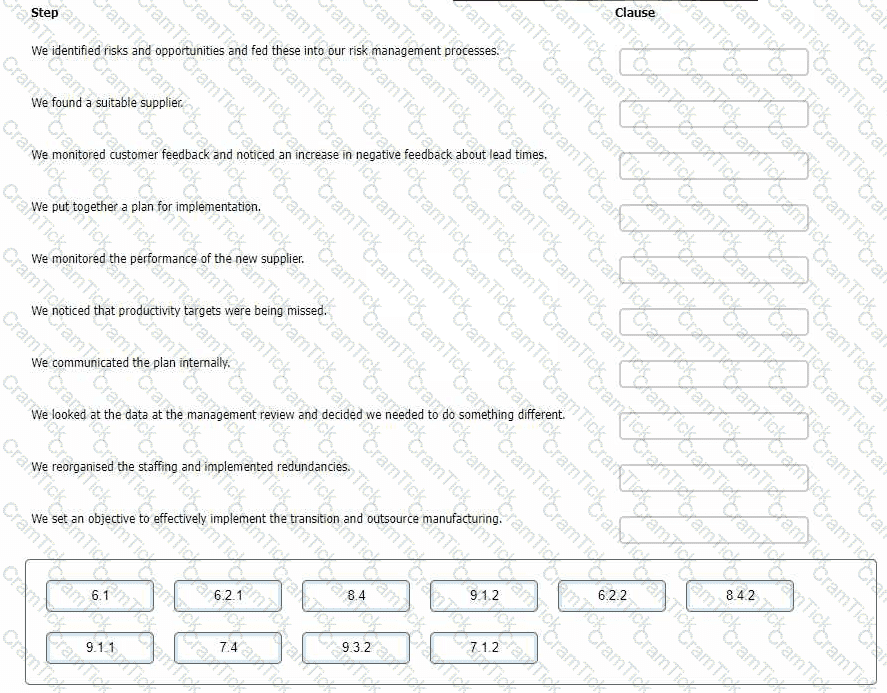
Whistlekleen is a national dry cleaning and laundry organization with 50 shops. You are conducting a surveillance audit of the Head Office and are sampling customer complaints. You find that 80% of complaints originate from five shops in the same region. Most of these complaints relate to damage to customer laundry. The Quality Manager tells you that those are the oldest shops in the organization. The cleaning equipment needs replacing, but the organization cannot afford it now. Complaining customers are offered a financial incentive to close the complaint.
On raising the matter with senior management, you are told that there are plans to replace the equipment in these shops over the next five years.
Select the one option which correctly describes the non-conformity to be raised against ISO 9001.
You are carrying out an audit at a single-site organisation seeking certification to ISO 9001 for the first time. The organization manufactures cosmetics for major retailers.
You are interviewing the Manufacturing Manager (MM).
You: "I would like to begin by looking at the cleaning controls."
MM: "We record the cleaning of the equipment at the end of every batch. This document details the minimum cleaning frequency and the procedures to follow for all areas and each item of equipment. The person who carries out the cleaning puts their initial on the document and records the time and date alongside."
Narrative: You sample production records over 3-days and note down evidence of nonconformity as per the table below.
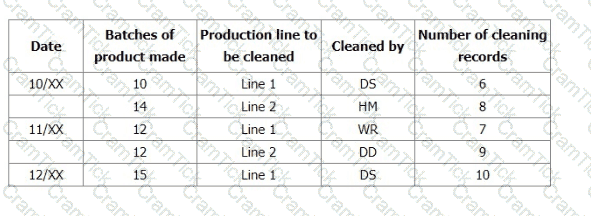
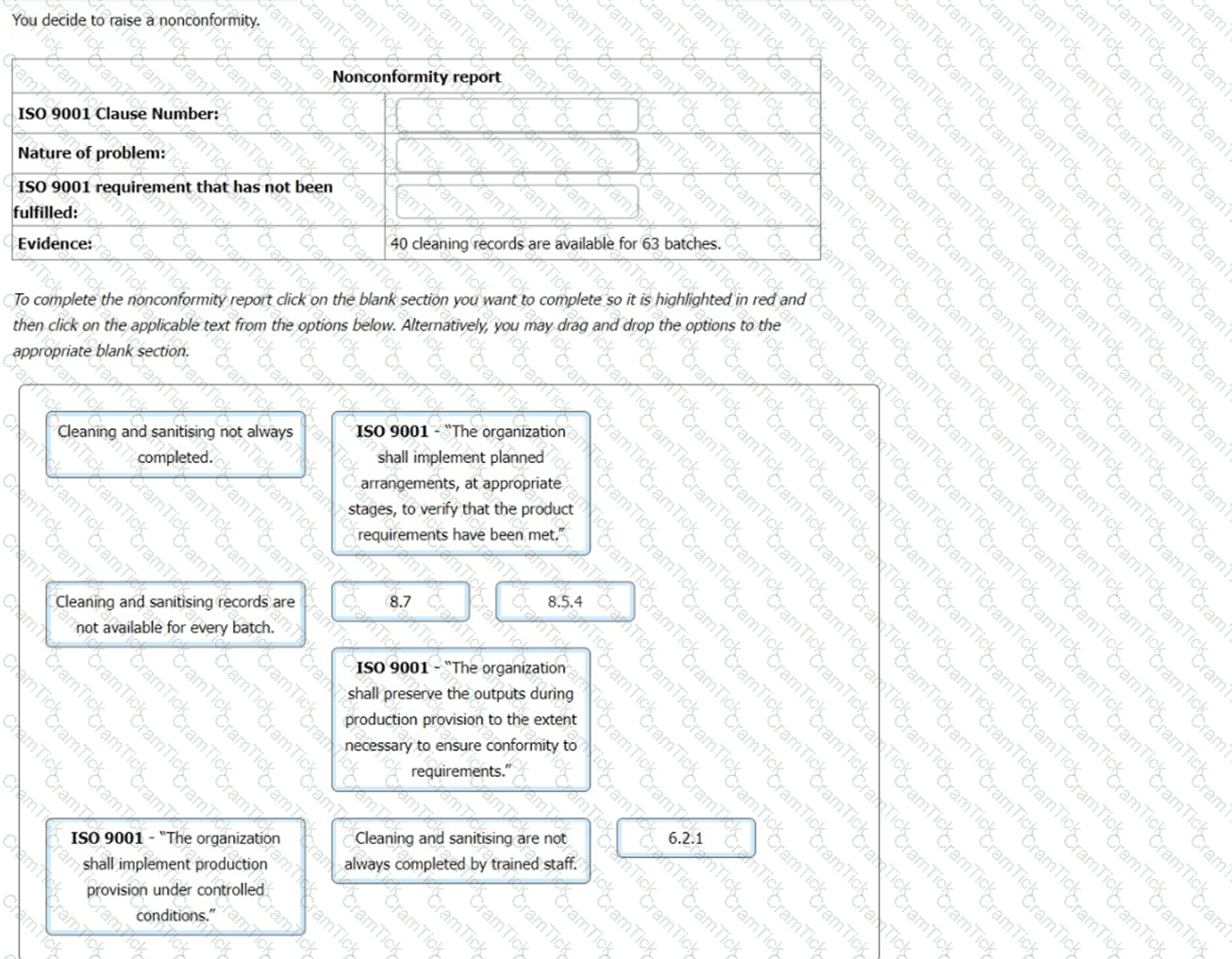
How can an organization ensure the objectivity and impartiality of the internal audit function?
An organization has decided to implement a QMS based on ISO 9001. What should they consider when determining internal issues?
Scenario 6: Davis Clinic (DC) is an American medical center focused on integrated health care. Since its establishment DC was committed to providing qualitative services for its clients, which is the reason why the company decided to implement a quality management system (QMS) based on ISO 9001. After a year of having an active QMS in place, DC applied for a certification audit.
A team of five auditors, from a well-known certification body, was selected to conduct the audit. Eva was appointed as the audit team leader. After three days of auditing, the team gathered to review and examine their findings. They also discussed the audit findings with DC's top management and then drafted the audit conclusions.
In the closing meeting, which was held between the audit team and the top management of DC. Eva presented two nonconformities that were detected during the audit. Eva stated that the company did not retain documented information regarding its outsourced services for an analysis laboratory and regarding the conducted management reviews. During the closing meeting, the audit team required from DCs top management to come up with corrective action plans within two weeks. Although the top management did not agree with the audit findings, the audit team insisted that the auditee must submit corrective actions within the given time frame in order for the audit activities to continue.
Once the action plans were evaluated, the audit team began preparing the audit report. Eva required from the team to provide accurate descriptions of the audit findings and the audit conclusions. The report was then distributed to all the interested parties involved in the audit, including the certification body Based on the report, the certification body together with Eva, as the audit team leader, made the certification decision.
Based on the scenario above, answer the following question:
The audit team delayed audit activities until DC’s top management submitted their action plans. Is this acceptable?
You are conducting a third-party audit to ISO 9001 and interviewing the Training Manager. She explains that training is more
important than ever because the organisation has had to reduce the number of staff employed. Many of the remaining staff
are now required to be 'multi-skilled'. You ask to see plans for the multi-skilling training and are shown plans that look
comprehensive, and include both 'on the job" training and internal and external training courses.
The records indicate that several staff required parts of their training to be repeated one month after the first training was
provided. You ask why this was needed and are told that an investigation of customer complaints identified that several staff
members did not complete certain tasks in the correct manner. The extra training was therefore recommended as a
corrective action.
Based on this interview, which two of the tollowing audit trails would be the most appropriate to follow?
Select the two most appropriate audit trails from the following.
Which action indicates that an organization is meeting the requirements of ISO 9001 regarding nonconforming outputs?
Whistlekleen is a national dry cleaning and laundry company with 50 shops. You are conducting a surveillance audit of the Head Office and are sampling customer complaints. You find that 80% of complaints originate from five shops in the same region. Most of these complaints relate to damage to customer laundry. The Quality Manager tells you that these are the oldest shops in the company. The cleaning equipment needs replacing but the company cannot afford it at the moment. You learn
that the shop managers were told to dismiss most of the claims on the basis of the poor quality of the laundered materials.
On raising the matter with senior management, you are told that there are plans to replace the equipment in these shops over the next five years.
When reviewing the customer complaint file, you find that the organisation is facing a legal dispute with a customer over damage to an expensive cashmere coat.
Select the best option for how this should be handled by the Quality Management System.
Which type of audit risk is the risk that a significant defect may occur in the QMS, although the organization has internal control mechanisms in place?
In the context of a third-party audit, select the issue which is not expected to be included in the audit plan.
Select the term which best describes the quality management system process of modifying a non-conforming product to bring it within acceptance criteria.
In the context of a third-party audit, match the activity with the party responsible in relation to the audit process.

An audit team leader arrives at a printing organisation to carry out a Stage 2 audit for a certification body. At a meeting with the Quality Manager, she is told that they have won their biggest contract from a computer
manufacturer to print and compile computer documentation packages. They have leased the unit next door for space reasons but have never worked in this sector before. The Quality Manager wants the ISO 9001
certificate to cover the new contract.
Which one of the options is the correct response by the auditor?
Which one of the following documents addresses audit time calculation for third-party certification audits?
During a second-party audit, the auditor examines the records that are available for the external provider, ABC Forgings, to whom manufacturing has recently been outsourced.
There are standard external provider checklists for three competitors for the contract and there are inspection records from the trial manufacturing batches produced by ABC Forgings. There is no documented evidence of the criteria used to confirm the appointment of ABC Forgings, and no contract or terms and conditions. Ongoing monitoring indicates that external provider performance is satisfactory, but no documented information has been retained.
Select two options for the evidence which demonstrates a nonconformity with clause 8.4 of ISO 9001.
One of the conflict resolution techniques is toning down. How is the conflict managed in that case?
You are carrying out an audit at a single-site organisation seeking certification to ISO 9001 for the first time. The organisation manufactures cosmetics for major retailers.
You are interviewing the Manufacturing Manager (MM).
You: "I would like to begin by looking at the cleaning controls."
MM: "We record the cleaning of the equipment at the end of every batch. This document details the minimum cleaning frequency and the procedures to follow for all areas and each item of equipment. The person who carries out the cleaning puts their initial on the document and records the time and date alongside."
Narrative: You sample production records over 3-days and note down evidence of nonconformity as per the table below.

You decide to raise a non-conformity.
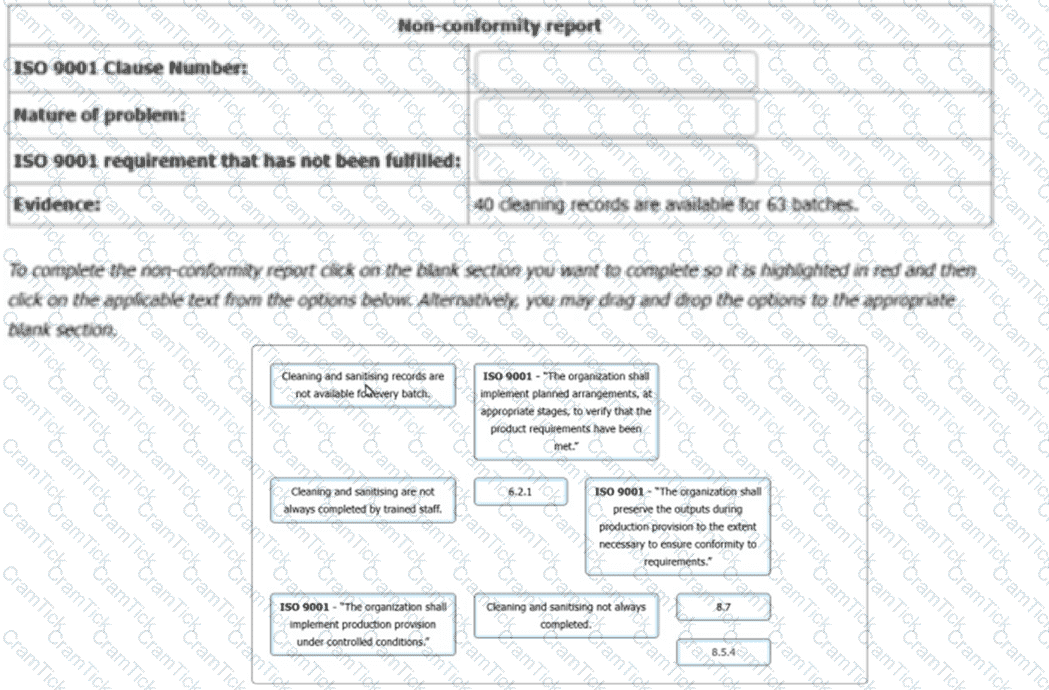
The Closing meeting of a second-party audit was planned for 6 pm with the general manager and the quality manager.
At 6 pm, when the audit team enters the meeting room, only the Quality Manager is present and walting for them.
The dialogue among them is as follows:
Auditor team leader: "Good evening, could you please inform the general manager that we are ready to start with the closing meeting?"
Quality manager: "Good evening. I am sorry to inform you that the general manager will not be able to attend the meeting. He will try to
participate virtually to make some closing remarks."
Auditor team leader: "OK. We identified seven nonconformities - these are the reports. Could you please review them and sign them?"
Quality manager: "OK. As you know, I reviewed them after yesterday's meeting and accept of all them, where shall I sign?"
General manager (from speakers in the room and addressing the quality manager): "Hold on! Do not sign the two nonconformities related to ABC
Bank! I have just checked, and we did not provide any services to ABC Bank during September! You can sign the remaining five nonconformities."
How would you proceed with the audit? Select one.
The certification body has not been able to verify the implementation of corrective actions for any identified major nonconformity within six months after the last day of the Stage 2 audit. What must the certification body do in this case?
Scenario 4:
TD Advertising is a print management company based in Chicago. The company offers design services, digital printing, storage, and distribution. As TD expanded, its management recognized that success depended on adopting new technologies and improving quality.
To ensure customer satisfaction and quality improvement, the company decided to pursue ISO 9001 certification.
After implementing the QMS, TD hired a well-known certification body for an audit. Anne Key was appointed as the audit team leader. She received a document listing the audit team members, audit scope, criteria, duration, and audit engagement limits.
Anne reviewed the document and approved the audit mandate. The certification body and TD’s top management signed the certification agreement.
Before contacting TD, Anne reviewed the audit scope and noticed that TD made changes to it due to the adoption of new printing equipment. However, Anne disagreed with the changes, stating they would affect the audit timeline. She considered withdrawing from the audit.
How do you assess the situation presented in the last paragraph of scenario 4?
An ISO 9001 certified organization sells packaged food. To maximize the benefits of third-party certification to the organization and stakeholders, the organization has labelled their product 'ISO 9001 certified product' and is selling it as 'quality food'.
Which TWO of the following describes this situation in the context of the purpose and benefits of third-party ISO 9001 certification?
Select six tasks you would expect to be completed at the audit team meeting of a third-party audit team leader and his audit team in preparation for a Closing meeting for a four-day initial certification audit.
In a third-party audit to ISO 9001, select two options of when the organisation is required to act in response to reported findings.
Scenario 3:
Fin-Pro is a financial institution in Austria offering commercial banking, wealth management, and investment services. The company faced a significant loss of customers due to failing to improve service quality as they expanded.
To regain customer confidence, top management implemented a QMS based on ISO 9001. After a year, they contacted ACB, a local certification body, to pursue ISO 9001 certification.
The audit team was led by Emilia, an experienced lead auditor, and included three auditors. After an agreement was reached, ACB sent the audit objectives to the audit team.
The audit team began by gathering information about Fin-Pro’s understanding of ISO 9001 requirements. While reviewing documented information, they noticed missing records of training and awareness sessions. They conducted employee interviews to verify attendance.
The team also reviewed the organizational chart and job descriptions to confirm employee competence. They observed the company’s working environment (social, psychological, and physical conditions).
The audit team analyzed the evidence and prepared an audit report with findings and conclusions.
ACB sent the audit objectives to the audit team after an agreement was reached. Is this acceptable?
Scenario 7: POLKA is a car manufacturing company based in Stockholm, Sweden. The company has around 14,000 employees working in different sectors which help with the design, painting, assembling, and test drives of the final product. The company is widely known for its qualitative products and affordable prices. In order to retain their reputation, POLKA implemented a quality management system (QMS) based on ISO 9001.
Before applying for certification, the company decided to conduct an internal audit to check whether there are any nonconformities in their QMS and if the requirements of ISO 9001 are being fulfilled. The top management appointed Sean, the internal auditor, as the team leader of the internal audit team. Sean required from the top management to have unrestricted access to the employees and executives of POLKA and to the documented information. Furthermore, Sean required to establish a team with a large number of auditors, considering the size and the complexity of the organization. The top management of POLKA agreed with Sean's requirements.
The top management, in cooperation with Sean, assigned 10 more employees to the audit team. Following that. Sean planned the audit activities and assigned the roles and responsibilities to each auditor. They began by interviewing employees of different manufacturing departments to check whether they are aware of the process of the QMS implementation. While conducting these activities, one of the auditors asked Sean for permission to audit the department in which he worked on a daily basis, as he was very familiar with the processes of the department.
Along the way, the teams findings showed that the staff were trained, documented information was updated, and the QMS fulfilled the requirements of ISO 9001. The internal audit took three weeks to complete, and on the last week the audit team held a final meeting
The team shared their results and together drafted the audit report This report was submitted to the top management of the company. The report was maintained as documented information, and was available to the relevant interested parties.
Based on the scenario above, answer the following question:
Sean requested unrestricted access to the employees, executives, and documented information of POLKA. Is this in accordance with audit best practices?
According to ISO 19011, what two activities take place during the conduct of a audit follow-up?
Scenario 2:
Bell is a Canadian food manufacturing company that operates globally. Their main products include nuts, dried fruits, and confections. Bell has always prioritized product quality and has maintained a good reputation for many years. However, the company's production error rate increased significantly, leading to more customer complaints.
To increase efficiency and customer satisfaction, Bell implemented a Quality Management System (QMS) based on ISO 9001. The top management established a QMS implementation team comprising five middle managers from various departments, including Leslie, the quality manager.
Leslie was responsible for assigning responsibilities and authorities for QMS-related roles. He also suggested including a top management representative in the QMS team, but top management declined due to other priorities.
The team defined the QMS scope as:
"The scope of the QMS includes all activities related to food processing."
Leslie established a quality policy and presented it to the team for review before top management approval. Top management also proposed a new strategy for handling customer complaints, requiring biweekly customer surveys to monitor customer perceptions.
Which situation presented in scenario 2 is NOT compliant with ISO 9001?
Below are four of the seven principles on which ISO 9000 series are based. Match a potential benefit to each of the quality management principles (QMP).

Scenario 4:
TD Advertising is a print management company based in Chicago. The company offers design services, digital printing, storage, and distribution. As TD expanded, its management recognized that success depended on adopting new technologies and improving quality.
To ensure customer satisfaction and quality improvement, the company decided to pursue ISO 9001 certification.
After implementing the QMS, TD hired a well-known certification body for an audit. Anne Key was appointed as the audit team leader. She received a document listing the audit team members, audit scope, criteria, duration, and audit engagement limits.
Anne reviewed the document and approved the audit mandate. The certification body and TD’s top management signed the certification agreement.
Before contacting TD, Anne reviewed the audit scope and noticed that TD made changes to it due to the adoption of new printing equipment. However, Anne disagreed with the changes, stating they would affect the audit timeline. She considered withdrawing from the audit.
In scenario 4, the audit team determined the audit feasibility by considering only the resources available for the audit. Is this acceptable?
Which two of the following auditors would not participate in a first-party audit?
A small cleaning services organisation is about to start work on a hospital cleaning contract for the local Health Trust. You,
as auditor, are conducting a Stage 2 audit to ISO 9001 and review the contract with the Service Manager. The contract
requires that a cleaning plan is produced.
You: "How was the cleaning plan for the contract developed?"
Service Manager: "We have a basic template that covers the materials, labour requirements and cleaning methods to be
employed. Some of that is specified by the customer."
You: "How does the plan deal with locations like the intensive care wards and the operating theatres, which are included
in the contract?"
Service Manager: "The basic plan covers general wards, but we will do more frequent cleaning in those areas if the
hospital requests it."
You: "Are you aware of the regulatory requirements for cleaning standards in hospitals?"
Service Manager: "No. We depend on the hospital to look after that side of things in the contract."
You decide to raise a non-conformity against section 8.2.2.a.1 of ISO 9001.
You decide to raise another non-conformity against section 8.2.4 of ISO 9001 when finding that the
cleaning plan was amended without the agreement of the Health Trust. A different cleaning chemical was
substituted to that specified in the contract. At the follow-up audit, the corrective action proposed was to
"obtain a concession from the Health Trust for use of the new chemical."
Which one of the following options is the reason why you did not accept this action taken?
You are auditing an organisation that has been certificated to ISO 9001 for ten years. The organisation is a privately-owned, multi-site car tyre fitting
organisation. You are auditing one of the sites. You are auditing the car tyre fitting service. You are interviewing the Site Manager (SM).
You: "Would you explain the car tyre fitting service?"
SM: "Of course. Customers typically call us by phone with their requirements. We ask them what they want. We check whether we have the tyres
they need in stock. If we don't have the tyres in stock, we contact our supplier to confirm when they would be able to supply the tyres. We then
determine the cost. We then check what availability we have in our busy schedule to fit the new tyres. We then inform the customer with details of
cost and when we can fit the tyres. If the customer is happy to proceed with the booking, we update our Work Schedule. The same process applies
for customers who walk into our office and for online requests."
You: "What information do you retain should there be a defect reported by a manufacturer of tyres that you have fitted?"
SM: "We maintain records of customer names, addresses and contact phone numbers. We maintain a record of the type of tyre fitted and the tyre
manufacturers batch information. We also maintain a record of the registration numbers of the vehicles we have fitted tyres to. All records are in our
Work Schedule."
Which two of the following options you would take to enable you to gather further audit evidence to validate what the Site Manager
has told you?
Scenario 3:
Fin-Pro is a financial institution in Austria offering commercial banking, wealth management, and investment services. The company faced a significant loss of customers due to failing to improve service quality as they expanded.
To regain customer confidence, top management implemented a QMS based on ISO 9001. After a year, they contacted ACB, a local certification body, to pursue ISO 9001 certification.
The audit team was led by Emilia, an experienced lead auditor, and included three auditors. After an agreement was reached, ACB sent the audit objectives to the audit team.
The audit team began by gathering information about Fin-Pro’s understanding of ISO 9001 requirements. While reviewing documented information, they noticed missing records of training and awareness sessions. They conducted employee interviews to verify attendance.
The team also reviewed the organizational chart and job descriptions to confirm employee competence. They observed the company’s working environment (social, psychological, and physical conditions).
The audit team analyzed the evidence and prepared an audit report with findings and conclusions.
Which statement below represents the level of responsibility demonstrated by the audit team in scenario 3?
Confidence in the audit process and its ability to achieve its objectives depends on the competence of those involved in performing audits:
According to ISO 19011, select the two participants who need to be competent in performing audits.
ISO 9001 |


